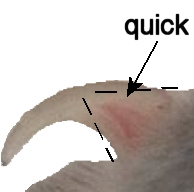Trimming your cat's claws
There are times when it is a good idea to trim a cat's claws. The idea has certainly occurred to anyone who has sadly beheld a shredded sofa, set of nylons, or even a hand offered in friendship. There are also times when claw trimming is good for the cat; and not just as a humane alternative to the drastic - and in some places illegal - practice of de-clawing. Occasionally a cat may have a genetic trait which prevents a claw from being retracted, and many other cats can suffer from split or broken nails which would benefit from a trim.
However, as any human who has a cat will know, one's feline friend does not necessarily appreciate something just because it is for her own good. Cats don't like people messing with their paws. If you go straight in and start trimming the claws without preparing the cat beforehand, donít expect co-operation from your pet. In fact your cat may well try to make use of her claws while she still has them intact.
Start gently. Kind of like a first date when you want to persuade the opposite party that getting one's hand held does not mean that something nasty is about to happen. So hold your cat's paw lightly, or just stroke it while she is relaxed. Generally, the cat will initially react by politely but firmly taking her paw back and giving you a suspicious look, but eventually she will recognise paw stroking as part of her usual interactions with you.
Once that happens (and it may not - some cats are incurably suspicious) you can move on to the next stage. Start taking her paw and putting it on top of your palm, gently massaging it. Combine this with general petting and stroking so your cat feels relaxed. It's not a good idea to start trimming claws until the cat is comfortable with you holding her paws. Anyway, holding a paw allows you to inspect the claws without your cat freaking out and giving you a really close look at them. If you have any treats your pet is particularly fond of, you can offer them afterwards so the cat comes to consider having her paws handled as a positive experience.
Trimming tips
Before trimming the nails make sure that the cat is sitting comfortably on your lap so the front paws are in front of you. Remember that the first time you trim her nails, the cat will probably be somewhere between unhappy and hysterical, so only proceed if you are sure it is safe for both of you. While are concentrating on one paw, don't forget the other three, which the cat may use to defend herself. Depending on your cat, wrapping the beast in a towel may help to restrain her, but if it comes to that extreme, you might need to consider if the project is so essential after all.

A cat's claws are retractable so you have to apply gentle pressure to the paw to see the claw in full. Cats' claws have a blood supply, which you'll see as a pinkish tinge in the upper part of the nail. This is called the quick (i.e. living tissue). Do not cut through it. Make sure that there are at the very least 2-3 millimeters distance between your cut and the quick. If you are unsure, cut just the very tip of the nail. In some cats the nails are quite dark so it is not always easy to differentiate between the quick and the rest of the nail. Don't cut unless you are sure that you can do it without harming the cat. To concentrate your thoughts, imagine how youíd feel if a large person held you down and started cutting your fingernails below the quick.
Don't try to rush the job. It is better to trim just one or two claws than trying to rush the job and finishing with a traumatized and possibly injured cat (and/or a traumatized and possibly injured human).
There are a large number of clippers available from pet stores. Choose the one which is best for you. Some people prefer to use the standard human nail clippers. The important thing is that the clippers are sharp so the cut is nice and clean and does not split the nail as the claw is trimmed.
Holding the clippers at a right angle to the nail and cutting across can make the cut less clean and leave the claw with a tendency to split. It is better to hold the clippers vertically so that the claw is trimmed from bottom to top. This way there is less chance of the nail splitting. The video below shows and compares those two techniques.
Cutting too close to the quick
If you do cut the nail too close to the quick, your cat may well point this out with considerable emphasis. The claw may also start bleeding, so apply gentle pressure to the tip of the bleeding nail to stop the blood. If the bleeding persists apply a styptic pencil to the bleeding claw, or put some styptic powder to stop the bleeding. Donít expect your cat to forgive you soon.
Some cats love and trust their humans to the point where having their claws trimmed is no big deal. Other cats may put up with the experience under protest, and others will not tolerate it no matter what. Remember that some cats go their entire lives without getting their claws trimmed, and do a pretty good home-made manicure with their own fangs when the need arises. So donít feel you have to trim your catís claws as a matter of course. There are other ways to protect your sofa, after all.
